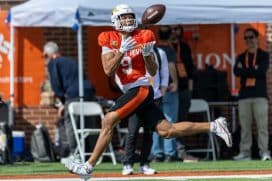Phillies
Phillies-Dodgers Rivalry – Dick Sisler sends Phils to World Series on Season’s Final Day
Disclosure
We sometimes use affiliate links in our content, when clicking on those we might receive a commission – at no extra cost to you. By using this website you agree to our terms and conditions and privacy policy.
Have you ever wondered why the Phillies teams between the two world wars are rarely written or talked about? Aside from the fact that nobody alive remembers watching those teams in person, they were absolutely putrid. The Phillies first run of success in the 20th century took place between 1913 and 1917 and in that five year span the club finished last once (1914), second three times (1913, 1916, 1917) and first once (1915). Once that core was sold off, traded, or faded into obscurity the team essentially took up permanent residence at the bottom of the National League. In the 31 seasons between 1918 and 1949, the Phillies finished last an astounding 16 times, second last 7 times and posted a winning record once in 1932. The National League had to take over the club for Phillies owner Gerald Nugent because he couldn’t pay the bills. The League sold the team to New York lumber executive William Cox who was banned from baseball for life by Commissioner Kenesaw Mountain Landis in November for, get this, betting on the Phillies to win. Fascinating. But fortune shone on the club when they were next sold to the Carpenter family. Robert Carpenter Sr. was married to a DuPont and for the first time in decades, the club was run by an owner who could afford to put money into the team to make it a winner.
The Carpenter’s first order of business was to hire Herb Pennock, the first general manager in team history. Carpenter and Pennock began to rebuild the club from the ground up with an ambitious five year plan. They outbid 15 other clubs for Curt Simmons, paying $65,000 for his services. They also unloaded a lot of money to secure Robin Roberts, Richie Ashburn, Del Ennis, Stan Lopata, Granny Hamner, Willie “Pudin’ Head” Jones, Bubba Church, and Bob Miller. Manager Ben Champan was relieved in 1948 and replaced by Eddie Sawyer, who managed some of the young core in the minors at Utica. Carpenter also added key veterans to the mix for the 1949 season including Dick Sisler and Eddie Waitkus. The Phillies finished 81-73 in 1949, the club’s first winning record since 1932. Sawyer corralled the team in the clubhouse after the last game of the 1949 season and told them “Come back next year ready to win the pennant.”
The average age of the 1950 Phillies was 26 years old, inspiring sportswriter Harry Paxton to dub the club “the Whiz Kids”. The team took over first place in early July and their lead ballooned to five games by August 12. They increased their lead to 7 1/2 games by September 20 with 11 games left in the season. Nothing comes easy for Philadelphia sports teams and the same can be said of the 1950 Phillies. Starting pitcher Curt Simmons’ National Guard unit was activated for service in the Korean conflict in September and he left the club on September 10. On September 15, the Phillies opened a doubleheader with the Cincinnati Reds. Bubba Church started for the Phils. He walked Johnny Wyrostek on four pitches with two outs in the third inning, bringing up the Reds’ hulking first baseman Ted “Big Klu” Kluszewski. Church rifled a first pitch fastball to Klu who line the ball back to Simmons, hitting him in the face. The Whiz Kids had lost two key starting pitchers in a matter of five days. Catcher Andy Seminick broke his ankle a few days later against the Giants but continued to play through the rest of the season. To make matters worse, the Phils lost 8 of their next 10 games setting up a crucial final game with the healthy Dodgers on October 1.
The Phillies led the Dodgers by one game in the standings coming into the final contest. The Phillies would secure the pennant if they beat the Dodgers. If the Dodgers won, it would force a tie at the top of the standings, resulting in a best-of-three playoff. On two days rest, Manager Eddie Sawyer gave the ball to Robin Roberts in the club house and said “good luck”. The Dodgers were used to the pressure. They were a team that finished in the second division only once during the 1940s and had been to three World Sereis in the decade (1941, 1947 and 1949). The Whiz Kids, on the other hand, were learning to deal with adversity on the fly throughout the 1950 season.
The game was played at Brooklyn’s legendary Ebbets Field before 35,073 fans. Don Newcombe, Brooklyn’s top pitcher, started for the Dodgers that day. Roberts recalled later that his arm was still very sore during warmups and he didn’t feel like he had his best stuff that day, but he looked over at Newcombe and thought “Hell, he is just as scared as I am. I knew that Newk had pitched almost as much as I had and probably was just as tired, nervous, and anxious as I was. Once I realized that the opposing pitcher was in the same shape, I relaxed and never gave another thought to how tired or nervous I was supposed to be.” Both pitchers were sharp to begin the crucial contest with only four hits and two walks being issued by both sides combined in the first five innings, but Philadelphia drew first blood in the top of the sixth. Newcombe retired the first two hitters of the inning, Eddie Waitkus and Richie Ashburn, on ground outs to first base. Dick Sisler hit a screamer between first and second base for a two out single. Next, Del Ennis dropped a lazy fly ball into center for a hit which advanced Sisler to third. Willie “Puddin’ Head” Jones hit a first pitch ball to center field, scoring Sisler. In the bottom frame, also with two out, Pee Wee Reese hit a ball hit a screen and dropped onto a ledge. The ball was in play, but it was unreachable and turned into a freak inside the park home run. The game remained tied going into the ninth.
In the top of the ninth, Andy Seminick reached on a single to third base but left the game when Sawyer replaced him with pinch runner Putsy Caballero. Caballero was caught stealing and the inning ended with a lineout to center field. Stan Lopata was brought in to replace the ailing Seminick with the score still tied. Roberts walked out to the pitchers mound to face the top of the Dodgers’ order in the bottom of the ninth. Roberts later recalled, “When I trudged out to face Brooklyn in the bottom of the ninth, I knew that if the Dodgers scored we would very likely lose not only the ballgame but also the pennant. My wife Mary and I had planned on taking a vacation in Florida after the season with some of my World Series money, and I remember for a brief moment thinking ‘If we don’t win this ballgame, we’re not going to get to Florida’.” Roberts walked Cal Abrams to start the inning and then surrendered a hit on a line drive to center. Two Dodgers on base with no out in a tie game and Brooklyn’s big power hitter, Duke Snider, strode to the plate carrying a .321 batting average with 31 home runs and 107 RBI with him. Roberts assumed Snider would bunt in the situation given no outs with a runner on second in a tie game, so he tossed the ball in not considering Snider would try to smash the ball. Snider slashed the ball into center field where Richie Ashburn was playing shallow. Ashburn fielded the ball on a bounce and rifled a strike to Stan Lopata – Cal Abrams was dead in the water and out by about 10 feet. The Phillies intentionally walked Jackie Robinson to load the bases and Roberts was able to retire Carl Furillo and Gil Hodges in succession to end the threat and preserve a tie, forcing extra innings.
Remember that this is baseball in 1950. Robin Roberts just retired the Dodgers in the ninth and was scheduled to lead off the top of the 10th. The Phillies had the future 1950 NL MVP in relief ace Jim Konstanty in the bullpen, but Sawyer instead allowed Roberts to lead off the frame! Roberts rewarded Sawyer’s trust with a leadoff single and advanced to second base when Eddie Waitkus also singled to center. Ashburn bunted down the third base line but Newcombe was able to field the ball and force out Roberts at third. Two on, one out and Dick Sisler walked to the plate. Newcombe went after Sisler after forcing Sisler to foul back the first two pitches of the at-bat. Sisler hung in the at bat and crushed a 1-2 pitch to deep left field; the three run home run proved to be the game winning hit. Roberts retired the Dodger side in order in the bottom of the 10th thus securing the Whiz Kids the 1950 NL flag and the franchises first pennant in 35 years. Roberts said that “when Eddie [Waitkus] caught that last pop foul, I had a feeling that I never experienced again in athletics. It was a feeling of relief, complete satisfaction, and exhilieration all rolled together…and my trip to Florida with mary was safe.”
Good news greeted Philadelphians as the read their morning Inquirer on October 2, 1950. The headlines red “S. KOREANS 7 MILES PAST 38TH PARALLEL; REDS’ REPLY ON SURRENDER AWAITED. Whiz Kids Win on Sisler Homer; Roberts Gets 20th”. In Brooklyn’s Daily Eagle, baseball coverage was absent from the front page, but a militaristic baseball metaphor did grace page 12 “Brooklyn’s banal charge at the 1950 pennant carried to the last trench of the enemy and there the last hope of victory was shot away by an expert machine gunner named Robin Roberts.”
Cartoon from Page 5 of the 10/4/1950 Sporting News.
The ensuing article talked about how R.M. Carpenter insured the club for $1,000,000 in 1950 which was ironic considering he was told the club wasn’t worth 30 cents when he bought the team in 1943.





